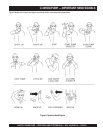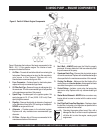
MAYCO C-30HDG PUMP — OPERATION AND PARTS MANUAL — REV. #6 (04/02/12) — PAGE 29
C-30HDG PUMP — OPERATING INFORMATION
OPERATING SUGGESTIONS
1. A well-planned location of the pump and routing of the hose
before starting a pour may save subsequent moves through-
out the job.
2. Before concrete is discharged into the hopper, it is suggested
that 3 to 4 gallons of water be sprayed into the hopper,
followed by approximately 5 gallons of a creamy cement and
water slurry (1/2 bag of cement to 5 gallons of water). This
procedure lubricates the hose and prevents separation and
blockages in the hose.
Getting the concrete to flow through the hose at the
start of the pumping cycle can be one of the most
critical operations of the pour. (
Manually
operate
the throttle when starting, NOT
remotely
)
If hoses or lines are
blocked
for any reason, or if the lines are
kinked
when starting up or during the pumping cycle, the
pump pressure could straighten out the kink or force out the
blockage. This rapid surge of material could cause the lines to
whip
or
move
in a manner that could cause injury to personnel.
Inspect the lines at all times to prevent the above
conditions
3. It is important that once the slurry procedure is completed,
and you have started concrete flowing through the hose, do
not stop the pour until all the slurry is pumped out and the
concrete has reached the end of the hose. The only time to
stop the pump at the start is if a blockage occurs.
4. When the pump is stopped for any reason during a pour; e.g.,
moving hose, waiting for redi-mix truck, the following sugges-
tions are offered:
A. Leave the hopper full of concrete at the time of shutdown.
It is important not to let the
redi-mix
driver wash too much
water into the hopper, as this could cause separation of
the concrete in the hopper.
B. If the
shutdown
period exceeds 2 to 3 minutes, turn off
the engine so the vibration does not separate the mix in
the hopper which can cause a blockage in the manifold
when the pump is started.
C. If it is necessary to wait 10 minutes or more for another
load of concrete, it is wise to start the pump and pump 6
or 8 strokes every 5 minutes to prevent setting of the mix
in the system. If waiting time is excessive, it would be wise
to wash out the pump and hoses and start over when the
new truck arrives.
D. When pumping stiff mixes and there is waiting time
between redi-mix trucks, it is advisable to add some
water to the last hopper of material and “hand mix” to
ensure an easier start with the following load.
E. When the pumping job requires a stiffer mix, the follow-
ing method is suggested for starting: Take a water hose
with a nozzle on it and apply water with a fine spray to the
concrete as it comes down the redi-mix chute into the
pump hopper after the slurry procedure is completed and
you are ready to start pumping.
Using this procedure will make it easier to pump through
the clean hose. Note: Once the concrete has reached the
end of the hose, do not apply any more water in this
manner as this procedure is used on the start only.
F. Hose sizing is very important: We strongly recommend
on harsh mixes, vertical pushes, stiff concrete, shotcrete,
long pushes, that a 2 -1/2” line be used as far as possible.
The advantages of using the 2 -1/2” line are improved
pumpability, less pumping pressure and less wear on the
pump.
5. Following the pump operation, proper wash out of all mate-
rials or “build-up” within the pump manifold and hoses will
prevent problems when starting the next job.
6. A thorough inspection of the drive components and greasing
of all bearings after each job will ensure adequate lubrication
and service to the pump which is normally operating in wet,
gritty conditions.
Over-greasing any
bearing
on your Mayco pump
will not damage the bearing.
WARNING - Hose Blockage Hazard


















